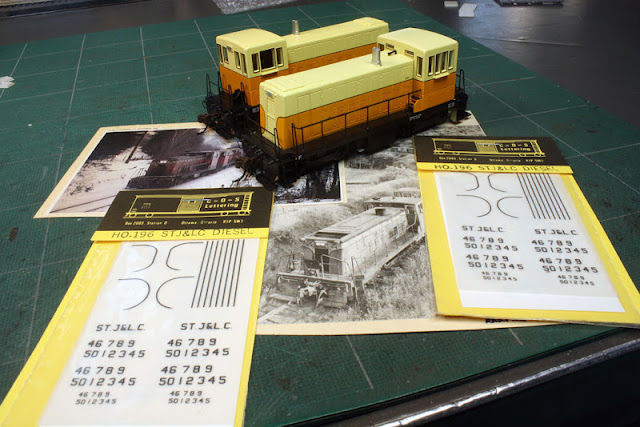 |
| A CV Accurail boxcar is first up ready for pick up on the White River Division. The CV boxcar in the rear is a Steam Shack resin kit. |
Reworking a Central
Vermont Accurail kit
 |
| Alan Irwin photo |
Back a few years ago I had an article published in the CVRHS Ambassador covering how I updated a CV Accurail 40' boxcar. A few weeks ago I got a nice thank-you for writing the article from CVRHS member Jack Kelley who used my instructions to complete the same project. He mentioned it was one of the few projects that he did without using an airbrush. I will included a photo of his model in another post...or a part two. I ran out of room in this blog once again and still had two more photos to include. I am finding deleting photos as I have done the last month does not add more space anymore, even when using smaller sized photo.
I thought this blog might be a good place to cover this project once again since most of you are not CVRHS members. This project is not too taxing and can add another interesting car to ones fleet.
A number of years ago Accurail
released a HO model of a 40 foot 6 panel wood boxcar with a Central Vermont
noodle design. The CV owned 200 of these cars, numbered 40000-40199 built in 1924-1925. These cars have an interior height of 8 feet 6 inches with a 6 foot wide door. A few did survive in service well past 1970. The CV Accurail kit is #7011 and
retailed for just over $10.
As mentioned before most of my modelling is during the 1950’s. I have built a small collection of rolling
stock so I can run a 1960’s or early 1970’s consist. The Accurail CV noodle outside
brace boxcar is a perfect fit. I had saved an article by John Nehrich (Mainline
Modeler Nov. 1984) explaining how one can convert a Train Miniature or Walthers car into a CV boxcar. This article is useful when working on the Accurail car. I was also
looking at completing the project without having to re-letter the car.
The hardest part of this makeover was scraping off the side ladders, grabs and car end support posts that were not seen in my photos of the prototype. All these changes are what make the model appear more like the prototype. I used Tichy grab irons as replacements for the ladders. The end bracing is Evergreen 2 by 4 styrene. The end cowl is made of scrap styrene. The cowl's middle width is 6” and is 30” long which widens to 10” at the ends. Score the bends and glue it on. I used Walthers Goo for this job.
I used the
trucks included in the kit but added Kadee #58 true scale couplers. I used parts I have on
hand including a new brake wheel and housing plus .010 wire rod. Wire operating
levers were bent and added. I applied a .010 wire bleed rod and chain to the
piston end as my only underbody detailing.This model does not have a fish belly underframe.
The
under body, truck and couplers are painted Floquil grimy black. All my new body
parts were airbrushed Floquil boxcar red. I could have just brush painted the spots that needed toughing up but I wanted to over sprayed the whole car with
a light coat of boxcar red to tone down the bright white lettering. I used chalk weathering
while the paint is still tacky to weather the body up.
These
changes really added a lot to the final appearance of my boxcar and I am really
glad I put the extra effort into the project and not just added the car to my train consist. Last year I finished a Train Miniature conversion for the earlier lettering scheme, such as the one John Nehrich built...you will find it in a later post.
I will be away sailing up north for most of the next two weeks and hope to figure out how to overcome the photo problem when I return...George Dutka
I will be away sailing up north for most of the next two weeks and hope to figure out how to overcome the photo problem when I return...George Dutka
 |
| The finished model in use. |


















